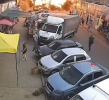ISUAL INVESTIGATIONS
Evidence Suggests Ukrainian Missile Caused Market Tragedy
Witness accounts and an analysis of video and weapon fragments suggest a Ukrainian missile failed to hit its intended target and landed in a bustling street, with devastating consequences.
By
John Ismay,
Thomas Gibbons-Neff,
Haley Willis,
Malachy Browne,
Christoph Koettl and
Alexander Cardia
Thomas Gibbons-Neff reported from Kostiantynivka and Druzhkivka in Ukraine, alongside John Ismay, a former bomb-disposal officer, in Washington and reporters in Ireland and New York.
The Sept. 6 missile strike on Kostiantynivka in eastern Ukraine was one of the deadliest in the country in months, killing at least 15 civilians and injuring more than 30 others. The weapon’s payload of metal fragments struck a market, piercing windows and walls and wounding some victims beyond recognition.
Less than two hours later, President Volodymyr Zelensky
blamed Russian “terrorists” for the attack, and many
media outlets followed suit. Throughout its invasion of Ukraine, Russia has
repeatedly and systematically attacked civilians and struck schools, markets and residences as a deliberate tactic to instill fear in the populace. In Kostiantynivka in April, they shelled homes and a preschool, killing six.
But evidence collected and analyzed by The New York Times, including missile fragments, satellite imagery, witness accounts and social media posts, strongly suggests the catastrophic strike was the result of an errant Ukrainian air defense missile fired by a Buk launch system.
The attack appears to have been a tragic mishap. Air defense experts say missiles like the one that hit the market can go off course for a variety of reasons, including an electronic malfunction or a guidance fin that is damaged or sheared off at the time of launch.
The likely missile failure happened amid the back-and-forth battles common in the surrounding area. Russian forces
shelled Kostiantynivka the night before; Ukrainian artillery fire from the city was
reported in a local Telegram group just minutes before the strike on the market.
A spokesman for Ukraine’s armed forces said the country’s security service is investigating the incident, and under national law can’t comment further.
Ukrainian authorities initially tried to prevent journalists with The Times from accessing the missile debris and impact area in the strike’s immediate aftermath. But the reporters were eventually able to get to the scene, interview witnesses and collect remnants of the weapon used.
The Strike
Security camera footage shows that the missile flew into Kostiantynivka from the direction of Ukrainian-held territory, not from behind Russian lines.
As the sound of the approaching missile is heard, at least four pedestrians appear to simultaneously turn their heads toward the incoming sound. They face the camera — in the direction of Ukrainian-held territory. Moments before it strikes, the missile’s reflection is visible as it passes over two parked cars, showing it traveling from the northwest.
Video
The missile’s warhead detonates a few yards above the ground shortly before impact, blasting metal fragments outward. The resulting crater and damage extending from the point of detonation is consistent with a missile coming from a northwesterly route, according to an explosives expert and a Times analysis.
Image
The impact point of the missile’s fuselage in relation to the scarring indicates that the missile flew into Kostiantynivka from a northwesterly direction.Credit...The New York Times
A Suspected Ukrainian Launch Site
Further evidence reveals that minutes before the strike, the Ukrainian military launched two surface-to-air missiles toward the Russian front line from the town of Druzhkivka, 10 miles northwest of Kostiantynivka.
Reporters with The Times were in Druzhkivka when they heard an outgoing missile launch at 2 p.m., followed a few minutes later by a second. By chance, one member of the team recorded the first launch in a voice message.
Video
Residents in Druzhkivka also reported an outgoing launch at that time on a local Telegram group. “One more,” a post at 2:03 p.m. said, referring to a second missile launch. Locals near the launches described them as abnormally loud — beyond the sounds of war they have become accustomed to — which tracks with
witness accounts of past Buk launches.
The timing of these launches is consistent with the
time frame for the missile that struck the market in Kostiantynivka, around 2:04 p.m.
Ukrainian Missile Likely Fell Short of Target
Map in Eastern Ukraine showing where missiles were launched, where they hit and territory occupied by Russia.
UKRAINE
Druzhkivka
Bakhmut
Missiles launched
at 2:00 p.m. and a
few minutes later.
Kostiantynivka
HELD BY
RUSSIA
as of
Sept. 6
Missile hit market
from northwest
at 2:04 p.m.
Kyiv
UKRAINE
Detail
area
5 miles
Sources: Institute for the Study of War with American Enterprise Institute’s Critical Threats Project (Russian-held territory as of Sept. 6); OpenStreetMap (roads)
By Scott Reinhard
Additionally, two witnesses who spoke to The Times said they saw the missiles being fired from Druzhkivka in the direction of the Russian front line around the time of the strike; one of them said he saw the missiles going in the direction of Kostiantynivka. A Ukrainian soldier stationed in Druzhkivka, who asked to remain anonymous, also said he heard two missile launches at around the same time.
One of the witnesses also said the missiles were launched from fields on the outskirts of the town, a place residents say is used by the Ukrainian military and from which they have previously seen air defense missiles.
Get our next visual investigation in your inbox. Our investigative journalists use evidence that's hidden in plain sight to present a definitive account of the news. Get an email as soon as our next Visual Investigation is published. Get it sent to your inbox.
Times reporters who visited the site saw indications that it had recently been used by the military, including trenches, trash pits and wide tracks consistent with a large military vehicle.
Another key indicator: scorch marks. Various ground-launched air defense missiles are fired from the rear of a large vehicle and burn the surrounding turf when they are fired. Analysis of before-and-after satellite imagery shows new scorch marks around the trenches on the day of the strike, possibly indicating that the site was used for launching missiles.
Several small trenches were dug in an area where residents said Ukraine’s military launches air defense missiles. The ground had recently been scorched and grass appeared to have been flattened by a large vehicle.Credit...The New York Times
ADVERTISEMENT
SKIP ADVERTISEMENT
The Missile
In the aftermath of the attack, Ukrainian authorities
said Russian forces used a missile fired by an S-300 air defense system, which Russia has used both to intercept aircraft and strike targets on the ground. But an S-300 missile carries a different warhead from the one that exploded in Kostiantynivka.
The metal facades of buildings closest to the explosion were perforated with hundreds of square or rectangular holes, probably made by cube-like objects blown outward from the missile.
Measurements of the holes — and fragments found at the scene — are consistent in size and shape with one weapon in particular:
the 9M38 missile, which is fired by the mobile Buk antiaircraft vehicle. Ukraine is known to use the Buk system, as is Russia.
Some of the holes are less than 10 millimeters in width, while others are slightly larger. The 9M38 contains
two different sizes of solid-metal cubic fragments: eight millimeters and 13 millimeters across.
ADVERTISEMENT
SKIP ADVERTISEMENT
Image
The size and shape of impact holes caused by fragmentation are consistent with a 9M38 missile.Credit...The New York Times
Image
A deformed cuboid pulled out of a crater is consistent with the size of metal fragments in a 9M38 air defense missile fired by a Buk launcher.Credit...The New York Times
A Times reporter also reviewed other missile fragments recovered from multiple locations in Ukraine that had been fired by Russian S-300, S-400 and Buk air defense systems, as well as two different American air defense systems. Their shapes and measurements show that the damage at the market site was most likely caused by an 9M38.
Two independent military bomb-disposal experts, who asked to remain anonymous so they could speak candidly, came to the same conclusion and said that the fragments and damage at the strike site are most consistent with an 9M38.
Several witnesses either heard or saw Ukrainian forces firing surface-to-air missiles from Druzhkivka toward Kostiantynivka at the time of the market strike. And evidence collected at the market shows that the missile came from that direction.
ADVERTISEMENT
SKIP ADVERTISEMENT
Why the missile, which has a
maximum range of just over 17 miles, may have landed in Kostiantynivka is unclear — though it’s possible it malfunctioned and crashed before hitting its intended target.
In any case, at such a short range — less than 10 miles — the missile is most likely to have landed with
unspent fuel in its rocket motor, which would detonate or burn upon impact, offering a possible explanation for the widespread scorch marks at the market.
Julian E. Barnes contributed reporting from Washington, D.C., and Aric Toler from New York. Additional research was contributed by Rob McDonagh of Storyful.
John Ismay is a Pentagon correspondent in the Washington bureau and a former Navy explosive ordnance disposal officer.
More about John Ismay
Thomas Gibbons-Neff is a Ukraine correspondent and a former Marine infantryman.
More about Thomas Gibbons-Neff
Haley Willis is a journalist with the
Visual Investigations team. She has shared in two Pulitzer Prizes for investigations into the U.S. military’s dismissal of civilian casualty claims and police killings during traffic stops.
More about Haley Willis
Malachy Browne is enterprise director of the
Visual Investigations team at The Times. He was a member of teams awarded the Pulitzer Prize for International Reporting in 2020 and 2023.
More about Malachy Browne
Christoph Koettl is a
Visual Investigations journalist with the Times video team, specializing in the analysis of satellite imagery, video and other visual evidence. He has shared in two Pulitzer Prizes for coverage of the civilian toll of U.S. air and drone strikes, and Russian atrocities in Ukraine.
More about Christoph Koettl
Alexander Cardia is a designer, animator and graphics editor with the
Visual Investigations team at The Times. He was among the recipients of the 2023 Pulitzer Prize for International Reporting for coverage of Russian atrocities in Bucha, Ukraine.
More about Alexander Cardia
Our Coverage of the War in Ukraine
How We Verify Our Reporting

www.nytimes.com








